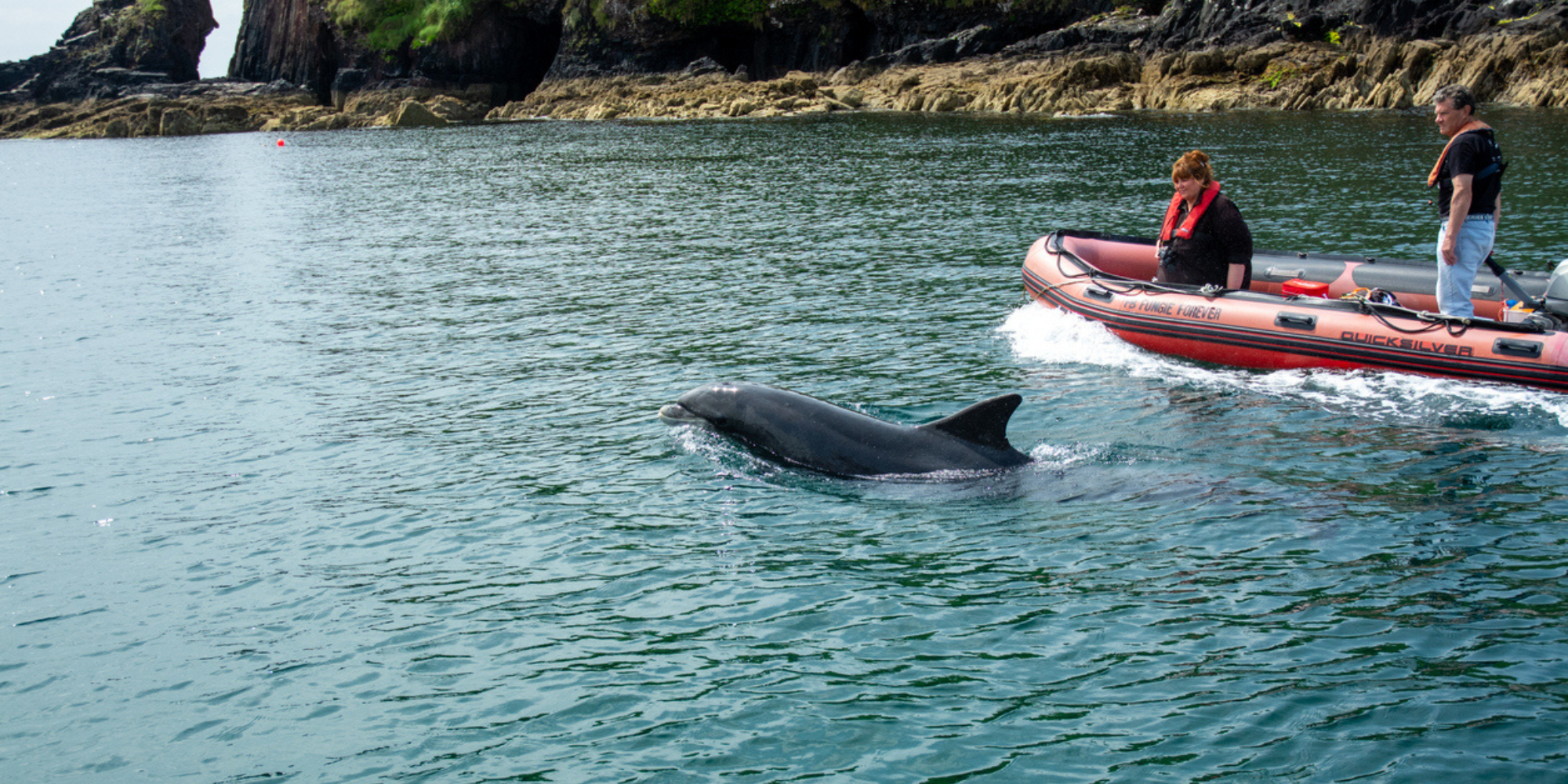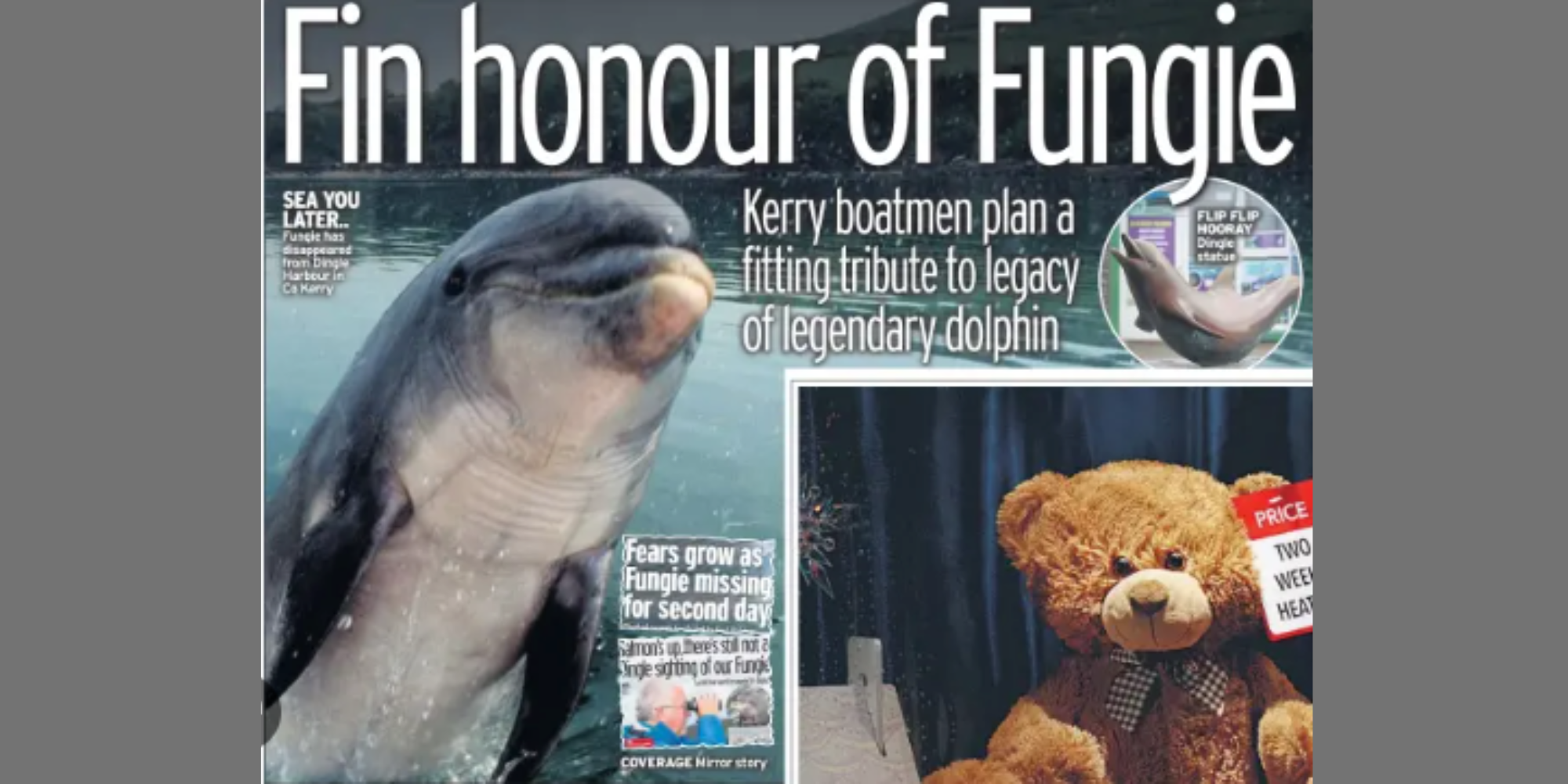We take a look at Fungie, a bottlenose dolphin living in Dingle, Ireland, who featured in news headlines and captured the hearts of people both there and around the world.
How Fungie’s story began
Back in 1983, a male Atlantic bottlenose dolphin was first noticed off the Kerry coast in Ireland.
The Dingle Harbour Lighthouse Keeper, Paddy Ferriter, began watching this lone wild dolphin as he escorted the town’s fishing boats to and from the harbour.
He had no pod of his own and stayed close to the harbour most of the year. This is relatively unusual for dolphins, who are social creatures and don’t tend to stay living in one place all the time.
The local fishermen enjoyed the company of this dolphin and gave him the name ‘Fungie’ (pronounced Fun-ghee). Over time, he developed from a timid observer of humans into a more playful character.
It wasn’t clear why Fungie was on his own – whether he had become separated from his pod or had struck out on his own. During the following years, he remained on his own, suggesting that he’d easily adapted to this solo dolphin life.
Fungie weighed in at around 500 lbs and measured four metres long. He had some body scars, suggesting he’d had interactions with other dolphins, porpoises or whales. Dingle Harbour, however, was a safe place for him, free of any aggressions with other animals.
Fungie puts Dingle on the map
During the 1980s, word soon spread about this friendly Dingle resident and a local tourist industry cropped up around him. Boat tours regularly took people out into the waters during the summer months. Fungie would come out to meet the boats, jumping high out of the water to the delight of people wanting to take a photo of him. Sea swimmers and kayakers also found Fungie siding up to them to say hello.
As Fungie attracted news headlines in Ireland and around the world, more international visitors came to see him. He was said to put Dingle on the map. Gift shops and pubs in the town took on his name, such was his fame.
Fungie kept up his regular habit of escorting fishing boats out to sea and back. He was also observed playing with small boats and sailing dinghies.
He enjoyed eating salmon and, on several occasions, he was spotted eating a fish commonly known as ‘Garfish’, a species not previously recorded as part of a dolphin’s diet. During winter, he had to travel a little further afield to find food.

Guinness World Record holder
In 2019, Fungie was named in the Guinness World Records as the longest recorded solitary dolphin in the wild. This was given after a report by global charity Marine Connection, which reviewed the world’s documented lone whales and dolphins.
Guinness World Records said that Fungie was estimated to be at least 40 years old.
Fungie disappears
Covid-19 pandemic restrictions in 2020 meant tour boats had to stop bringing groups out to sea. Early on in the pandemic, Jimmy Flannery, who runs Dingle Sea Safari, took it on himself to try and keep Fungie company.
“He craved human interaction, that’s what he lived for,” Jimmy told CNN in a 2021 article.
Tours eventually resumed but in October 2020, it was reported that Fungie had gone missing.
Up to then, he’d never disappeared for more than a few hours at a time so the local community was understandably concerned for his welfare.
Search for Fungie
A search operation got underway with a dozen boats involved. Search and rescue divers checked out coves and inlets where Fungie normally swam and a sonar scan of the seabed was carried out.
There was faint hope when a sighting was reported in the Irish media but it turned out to be another dolphin. As more time passed, it sadly became more unlikely that Fungie would be seen again. It’s thought that he probably died of old age – when bottlenose dolphins die, they tend not to wash up on land.
A memorial was held for Fungie on the one-year anniversary of his disappearance, with boat operators offering free boat trips out to the entrance of Dingle Harbour and local people gathering to remember him. Around 1,000 people turned out to mark the moment.

The Fungie Effect
Fungie made a lasting impression on generations of people and marine biologist Kevin Flannery, who has been observing Fungie since 1983, says he also helped people understand why they should care about the ocean.
“An awful lot of people got educated about the marine world in the realisation that it wasn’t the place where you dump plastic and things, that it was a living entity where you had all these whales, dolphins, cetaceans of all sorts – and it was a place to be taken care of,” he told CNN.
“I suppose in that sense Fungie has educated millions of people,” he added, saying that the dolphin has contributed to a sea change in attitudes around sustainability.
Many of the boat tours that were centred around seeing Fungie have since diversified their tours, offering private trips of the harbour, sea safaris, tours of the nearby Blasket Islands and eco-tours.
Fungie left a lasting impression not only on the people in the local community but the countless people from all over the world who came to see this solitary but playful wild dolphin.
